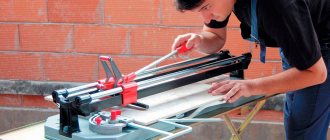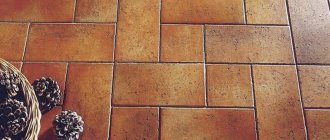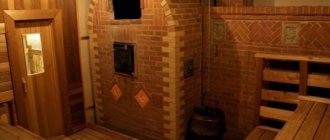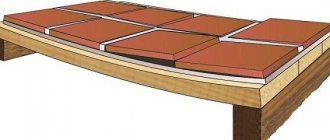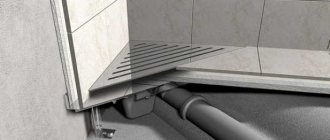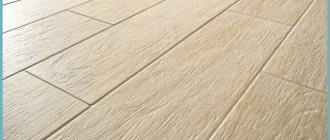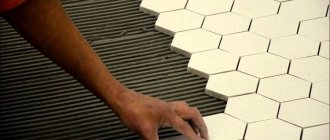Anyone who prefers to make repairs or do small jobs with their own hands has probably had to cut porcelain tiles at home. In the first tests, cutting porcelain tiles is more difficult than cutting tiles. It turns out a lot of defects, but in general the process itself is not much different from working with high-quality ceramic tiles.
The cutting line should be marked with an allowance for finishing.
Features of cutting porcelain stoneware
It should be noted that cutting very dense and hard porcelain tiles at home is sometimes even easier than in the case of ceramic tiles. Anyone who doesn’t believe it can try cutting overheated ceramics made on old Soviet or Chinese equipment at home. In comparison, cutting porcelain tiles does not look so problematic.
It is quite possible to cut porcelain stoneware without chipping, although some craftsmen claim that this is fundamentally impossible to achieve. If this were indeed the case, then most walls and steps covered with porcelain tiles would have wide joints, crooked and unattractive.
It's not even a matter of the hardness of porcelain stoneware. The technology for manufacturing artificial granite is such that as a result of pressing and deep firing, the material is obtained with virtually no internal stresses, and this is the key to the high quality of the cutting line.
In order to accurately and accurately cut porcelain stoneware at home, you only need to fulfill two conditions:
- Select the correct cutting mode, ensure constant and uniform pressure with the cutting tool on the cutting line of porcelain stoneware;
- Select the appropriate tool for the specific conditions of cutting the material.
It is clear that at home, the possibilities of cutting the material are significantly limited, but even in an apartment it is quite possible to cut porcelain stoneware without a tile cutter, although the amount of dust generated when working with electrical machines is initially scary.
Cutting ceramic tiles with a grinder
Cutting ceramic tiles at home is done using a grinder. If you don’t have a specialized tool for ceramics at hand, then an angle grinder is always handy. In addition, there are cases in which it is necessary to make subtle adjustments by cutting off only a thin strip of 0.5–2 cm. The tile cutter will not help in this case due to its widely spaced support legs.
How to cut ceramic tiles at home using a grinder? All you have to do is take a pencil or marker, make a line on the ceramic tile, and then cut it. You should monitor the heating during the process. You shouldn't cut it in one go. Otherwise, the product may crack. For the desired result, the movements of the grinder are made smooth, without pressing.
Advice! You need to walk the grinder along the drawn mowing line not in the very center, but along the mowing line, from the side of the cutting part. By cutting the ceramics along a strictly marked mowing line, the fragment will become smaller by a couple of millimeters.
Perfect cutting of porcelain tiles by hand, construction
How to properly cut ceramic tiles with a grinder? There are some tips for this:
- It is better to carry out the process in weight, in which case the vibration from the tool will be compensated by hands.
- After trimming, the edges may be sloppy. Therefore, a careful repeat pass is made at the site of the first cut.
- Sandpaper will help smooth out uneven surfaces.
- The grinder is a very dangerous tool. To protect yourself, you should wear gloves, wide safety glasses or a shield before cutting. You need thick clothing and leather shoes.
Recommendations for working with a tile cutter
We insert the tile into the tile cutter, align the markings on the tile and the special mark on the tool. We lower the handle and move it away from us with a smooth movement. The speed should be the same, the pressure should be uniform, then the glaze will be cut to the same depth. One cut with a roller is enough. If the movements are repeated several times, we can get a poor-quality fracture.
The tool is equipped with special claws, which, when lowered, break the tile into pieces of the desired size. The main thing is to press the lever sharply. All tile cutters, without exception, have a platform with a metal tubercle and soft linings.
When pressing with your paws on the edge of the tile, the cut is under maximum pressure. With the correct combination of the cutting line and the lining, the tiles will split very smoothly.
In words, this process may not be entirely clear, especially to beginners. It’s better to look visually and understand how to cut tiles with a tile cutter correctly.
Sources:
https://kitchenremont.ru/remont/poly/plitka-na-polu/rezka-keramogranita https://bouw.ru/article/rezka-plitki-iz-keramogranita-v-domashnih-usloviyah https://protechniky. ru/remont/sovety-spetsialistov-chem-i-kak-rezat-keramogranit-v-domashnih-usloviyah
Where to cut porcelain tiles
Oddly enough, it is the tiny ceramic dust formed when cutting artificial ceramic granite that turns into the main problem. At home, it is most convenient to cut the material directly at the place where it is laid.
If you plan to cut tiles with a tile cutter, then you can cut porcelain tiles in any suitable place. In this case, the amount of chips and dust generated is insignificant, but the productivity at home is relatively small.
For curly cutting or cutting fairly thick porcelain stoneware slabs, you will have to use a grinder or a machine. You will have to work at home either in the courtyard of the house, or you will have to sacrifice a bathroom or toilet.
The best way to cut porcelain stoneware
Dimensions of ceramic granite tiles (cm):
- 30x30;
- 45x45;
- 60x60
- 120x360.
The last size of porcelain tiles belongs to the so-called thin porcelain tiles, which are most often used in residential renovations. It is especially beautiful when decorating walls and plinths of facades of private houses. There is another way to cut porcelain tiles, but for small amounts of work - this is using a glass cutter.
READ How to insulate the underground floor in a private house
How to cut porcelain tiles at home
From a technology point of view, there are two main ways to cut porcelain stoneware. To do this, you can use various tools and devices, but, regardless of the quantity and type of technical equipment, porcelain stoneware is still cut using two methods:
- Mechanical cutting of porcelain stoneware. In this case, the cutting line is selected with an abrasive tool;
- Piercing method. A deep scratch is cut on the surface of the porcelain stoneware along the future separation line. Next, a bending or shearing force must be applied to the porcelain stoneware, and the tile will split exactly according to the markings.
At home, you can use both methods, depending on the tools at your disposal, the amount of work and the thickness of the material. In addition, we have to take into account the complexity of the cutting line configuration. For example, if you need to cut at home a tile that is quite large in size and simply will not fit into a tile cutter, then you will need to look for a diamond cutting wheel and a grinder. For cutting at home, this is one of the most reliable methods.
Having laid the tiles on a sheet of plasterboard, you can cut the porcelain tiles with a grinder along almost any trajectory; it is only important to take your time and evenly press the edge of the disk against the surface of the porcelain tiles. Otherwise, you can easily overheat the tile at the cutting point, which will lead to chipping.
How to cut porcelain tiles with a tile cutter
A tabletop or floor-mounted device for cutting any type of facing tile is a small frame with guides installed at the top and a carriage with a carbide head. The carriage is operated by a lever or by an electric drive. A simple and convenient mechanism for home use.
At home, a tile cutter turns out to be the most accessible tool for cutting porcelain stoneware
Before cutting porcelain tiles, the tiles are laid on the frame and secured with plastic or metal stops. This is necessary to ensure that the material does not move during the cutting process. Next, we bring the head to the edge of the tile until it touches and push the lever away from us; the carriage with a diamond or carbide tip evenly passes over the surface of the tile, leaving behind a deep scratch.
All that remains is to break the porcelain stoneware into two parts with a slight but sharp movement. One way to cut porcelain tiles with a manual tile cutter is shown in the video:
Advantages of the method:
- It is very easy and comfortable to cut porcelain stoneware at home; you can master the cutting technique even with minimal experience and qualifications;
- A minimal amount of dust is generated, which is very valuable at home, especially if you plan to lay porcelain tiles on a small area of the floor or wall.
An electric tile cutter is similar in design to a circular saw for processing and sawing wood. In order to cut porcelain stoneware, you just need to set the size of the strip to be cut, after which you can cut in unlimited quantities.
Home compact version of an electric tile cutter
The disadvantages of the device include the fact that it is possible to cut only material of a certain shape and size, for example, it is very difficult to cut a thin strip of porcelain stoneware or make a cut of a non-standard, curved shape.
It is easier to cut a thin strip of porcelain stoneware with a grinder
How to cut porcelain tiles with a glass cutter
The technology for cutting tile material using a manual glass cutter is not much different from the previous method. The only difference is that instead of a carriage moving along guides, you have to cut porcelain stoneware with a small tool held in your hand.
In fact, this is an ideal method if you need to cut material at home. Instead of a frame device, a regular table, a metal ruler and the glass cutter itself are used. In order to cut porcelain stoneware, it is enough to place a ruler on the marking line and draw a diamond along the cut line.
To break the material, the tile is laid on the table so that the scratch line coincides with the edge of the tabletop, pressed on top with a board and with a sharp movement the material is broken into two halves. There is no simpler method for home use, but to master the technique, you need to practice cutting on waste porcelain stoneware or glass.
The advantage of this method is its simplicity and minimal amount of equipment required. It is easier to store a manual diamond glass cutter at home than a tile cutter. The disadvantage of this method is that you need to learn how to draw a line along the markings with a diamond at a constant speed, and the main thing is to do this continuously, in one movement, while accurately measuring the force applied to the surface of the porcelain stoneware.
In addition, it is very difficult to cut material with a glass cutter without chipping, so if possible, it is best to use a diamond rather than a carbide roller.
How to cut porcelain tiles with a jigsaw
Quite an unusual way of sawing porcelain stoneware slabs. Using an electric or manual jigsaw to cut very dense and hard material always raises some doubts among beginners. However, cutting ceramics and porcelain tiles with a jigsaw is quite possible even at home, but only if certain requirements are met:
- The tool needs to be prepared for sawing porcelain stoneware. A thin, necessarily soft material, maybe paper or rubber, is glued onto the sole. This is done in order not to scratch or damage the front surface of the slab;
- The second step is to turn off the pendulum oscillation-movement on the hacksaw blade feeding mechanism, otherwise the saw will cut with chips on porcelain stoneware;
- A special type of diamond-coated hacksaw blade is used to cut tiles.
Important! There is no point in even trying to cut a slab with standard titanium knives; the cutting edge wears out literally in the very first minutes of work, and the process itself stops without even going a few centimeters.
In addition, the stove itself must be securely fixed to the countertop using clamps, and a rubber strip must be placed under the porcelain stoneware to reduce vibrations. The method for cutting porcelain tiles is quite simple and does not require special skills, ideal for use at home. It is valuable that a jigsaw is very easy to perform shaped cutting of porcelain stoneware.
You can also cut tiles with a hand jigsaw, sometimes there is simply no other tool at home, although it will take several times longer, but it is possible to get a very accurate and high-quality cut. In this case, the side edges of the hacksaw blade are ground off, and emery powder is fed into the seam during the sawing process.
Curvilinear cutting of porcelain tiles
Advice! If possible, it is better to replace the blade with diamond-coated wire; this method produces fewer chips, especially if you cut porcelain stoneware with periodic addition of water at the cutting point.
It is believed that this method is the cleanest of all mechanized options, which is especially important if you have to work at home, without an exhaust hood or a vacuum cleaner.
How to cut porcelain tiles with a circular saw
Porcelain tiles can be cut and cut without much trouble using a more powerful cutting tool, such as a hand-held circular saw. Engine speed and power allow you to cut almost anything at home, from wood to metal profiles.
In order to cut porcelain stoneware, the tool must be retrofitted:
- First, the standard carbide-tipped saw blade must be replaced with a diamond wheel;
- Secondly, a ring-bandage is placed under the disk mount, thanks to which it is possible to dampen vibrations and uncontrolled bending of a thin and flexible diamond wheel.
Converting a saw to porcelain stoneware
The process of sawing material is not much different from working with an electric tile cutter; the only difference is that the engine power is noticeably higher. Therefore, you need to carefully control the feed of the diamond wheel with minimal effort, otherwise the porcelain stoneware will quickly overheat and crack.
If you need to cut porcelain tiles in large quantities, then there is no better option than an electric machine.
This method of sawing porcelain stoneware is considered the most productive, but at home it is used for short-term trimming of a small amount of material. You can only work in the yard, garage, shed, but under no circumstances inside a living space. The amount of dust that is generated when sawing even a small amount of material is approximately an order of magnitude higher than all other cutting methods. The only indisputable advantage of this option is that using a circular saw and a diamond wheel you can cut porcelain stoneware at 45 degrees.
Water cutting of porcelain tiles
The most highly productive and at the same time accurate method of sawing very hard natural and artificial granites is considered to be the waterjet system. It allows you to cut out entire designs and three-dimensional images. The system is quite powerful and allows cutting porcelain stoneware up to 200 mm thick. At home, such equipment is not used for obvious reasons.
You can cut using water on a hydromechanical machine. The use of water or a water emulsion can significantly reduce the heating temperature of the tool and the porcelain stoneware itself. The result is less wear and higher surface quality. The emulsion is applied to the edge of the wheel, but not to the surface of the ceramic.
A diamond wheel mounted on the motor rotor is fed along the machine guides along the surface of the porcelain stoneware; coolant is supplied from a special reservoir directly to the cutting zone. This method is considered the most harmless, since almost all dust is washed off with water and removed from the surface of porcelain stoneware. It is clear that cutting material in this way is possible if you can find a separate room at home, for example, in a garage or shed.
Such machines have very high characteristics and cutting speed, therefore, if you plan to cut porcelain stoneware of complex shapes and sizes at home, then using a hydromechanical machine will be the best option.
Cutting with a manual tile cutter
There is only an electric tile cutter for porcelain stoneware. There is no specialized manual tile cutter for porcelain stoneware. But for these purposes you can use a good quality manual tile cutter. You will most likely not be able to find a cheap suitable tool, and if you use one, the result will simply be a broken tile.
Basic requirements for the tool:
A good frame with a powerful stiffener. Otherwise, when a tile breaks, the frame will bend and the tile will break out of line;
- No play in the carriage (usually depends on the thickness of the guides). With use over time, any manual tile cutter begins to play. Therefore, it is not recommended to use old, untested ones;
- The thicker the tile, the thicker the diameter of the cutting roller should be;
- The carriage should move smoothly. This is achieved by special bearings. A bearingless carriage can also have a smooth ride, but according to experience, it doesn’t last long and is unstable, i.e. One time it rolled smoothly, but the next time there was no guarantee.
- Mark the tiles; it is recommended to use a construction marker.
- Lay the tiles on the tile cutter exactly along the line.
- Carefully draw a line away from you with light pressure. In this case, it is important to maintain the same pressure throughout the entire line. Important! A line is drawn on porcelain stoneware once. Drawing multiple lines is unacceptable. Otherwise, the fault may not go along the line.
- Place the foot on the tile and press to break along the line.
- Sand the cut if necessary.
Please note the restrictions on using a manual tile cutter:
- only straight cuts through the entire tile;
- it is almost impossible to accurately break off strips less than 6 - 7 cm (depending on the thickness of the material);
- problematic, with chips, oblique lines break if the cut hits the ribs on the back side.
Advantages:
- speed of work;
- absence of dust and noise;
- ease of operation.
To obtain particularly neat lines, you can use the same technology as for the angle grinder. Draw a line with an indentation of 2-3 mm, and then sand it to the desired size. Used only in visible places.
Advice from professionals
Oddly enough, the greatest number of problems arise not even with the drive or tool used for processing porcelain stoneware, but directly with the diamond disc. The main complaint about diamond is the rapid loss of cutting ability. As a result, as feed and force increase, the edge of the wheel heats up and begins to lose diamond powder. If you try to cut at home in this mode for at least 10-20 seconds, then there will be nothing left of the expensive disk.
In this case, before each cut, the edge is cleaned and restored; at home, this can be done on ordinary red brick by making several small cuts. This removes soft material stuck to the diamond strip.
Experienced craftsmen, before cutting porcelain tiles, soak the material for 10-15 minutes in water. Artificial granite absorbs moisture very poorly, but a small amount of water still remains on the edge of the slab. As a result, the first time the cutting edge touches the surface, you are guaranteed to get a beautiful entry hole without chips.
